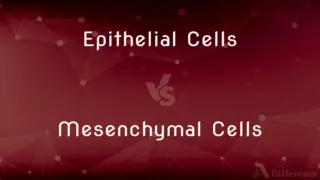P Type Semiconductor vs. N Type Semiconductor — What's the Difference?
By Tayyaba Rehman — Published on December 28, 2023
P Type Semiconductor has an abundance of holes and accepts electrons, while N Type Semiconductor has an excess of electrons and is electron-rich.
Difference Between P Type Semiconductor and N Type Semiconductor
Table of Contents
ADVERTISEMENT
Key Differences
P Type Semiconductor and N Type Semiconductor are two fundamental categories of semiconductors used extensively in electronics. A P Type Semiconductor is one where the majority charge carriers are holes. These "holes" are created by introducing certain impurities, called acceptors, into the semiconductor. On the other hand, an N Type Semiconductor is characterized by its majority charge carriers being electrons. This is achieved by introducing a different set of impurities, termed as donors.
In P Type Semiconductor, the acceptor impurity atoms have a higher tendency to accept an electron, thereby leading to a positive hole. It is aptly named the P Type because of its positive charge nature. Conversely, N Type Semiconductor is saturated with donor impurities that have an extra electron to spare. When they're introduced into the semiconductor, they create an excess of free electrons, making the semiconductor predominantly negatively charged, hence the name "N Type."
The behavior of P Type Semiconductor and N Type Semiconductor under an applied voltage also differs. When voltage is applied, the holes in a P Type move toward the negative terminal, while the electrons in an N Type rush toward the positive terminal. This distinction is pivotal when creating electronic devices like diodes, where P and N types are juxtaposed.
Electrically neutral in their resting state, both P Type Semiconductor and N Type Semiconductor have a balanced number of protons and electrons. The distinction between them isn't about an overall positive or negative charge but rather the dominant type of charge carrier present. While P Type is hole-dominant, N Type is electron-rich.
In essence, while both P Type Semiconductor and N Type Semiconductor serve as foundational pillars in electronics, their intrinsic characteristics, governed by the types of impurities introduced, are what set them apart. The delicate dance between the P's holes and N's electrons is what drives the world of modern electronics.
ADVERTISEMENT
Comparison Chart
Charge Carriers
Holes
Electrons
Type of Impurity
Acceptor
Donor
Response to Voltage
Holes move toward negative terminal
Electrons move toward positive terminal
Overall Charge
Electrically neutral with majority positive holes
Electrically neutral with majority negative electrons
Use in Diodes
Forms the anode
Forms the cathode
Compare with Definitions
P Type Semiconductor
Doped with acceptor impurities.
By introducing boron, the silicon wafer became a P Type Semiconductor.
N Type Semiconductor
Introduced with donor impurities.
By adding phosphorus, the pure silicon transformed into an N Type Semiconductor.
P Type Semiconductor
Holes move toward the negative terminal under voltage.
Under the influence of an external voltage, the P Type Semiconductor saw its holes migrating toward the negative side.
N Type Semiconductor
Electrons migrate to the positive terminal when voltage is applied.
Upon voltage application, electrons in the N Type Semiconductor swiftly moved to the positive end.
P Type Semiconductor
Often juxtaposed with N Type in electronic devices.
In a typical diode, the P Type Semiconductor is paired with an N Type to facilitate current flow.
N Type Semiconductor
Exhibits negative charge characteristics due to excess electrons.
The N Type Semiconductor's negative nature stems from its surplus of electrons.
P Type Semiconductor
Displays a positive charge characteristic due to holes.
The positive nature of the P Type Semiconductor is due to its abundance of holes.
N Type Semiconductor
Semiconductor dominated by electrons as charge carriers.
The N Type Semiconductor was teeming with free electrons.
P Type Semiconductor
Semiconductor with majority charge carriers as holes.
The P Type Semiconductor displayed a higher concentration of holes than electrons.
N Type Semiconductor
Essential for creating various electronic components alongside P Type.
In transistors, the N Type Semiconductor plays a crucial role in tandem with the P Type.
Common Curiosities
What makes an N Type Semiconductor negatively charged?
The excess of free electrons introduced by donor impurities.
Why are P and N Type Semiconductors pivotal in electronics?
They're foundational for devices like diodes, transistors, and integrated circuits.
What distinguishes a P Type Semiconductor from an N Type Semiconductor?
P Type has holes as major carriers, while N Type has electrons.
Do P Type and N Type Semiconductors have opposite charges?
They have opposite majority charge carriers, but both are electrically neutral overall.
Which impurity might you use to create an N Type Semiconductor?
Phosphorus is commonly used.
What happens when a P Type and N Type are brought together?
A PN junction is formed, which is foundational for diodes and other devices.
How is a P Type Semiconductor created?
By doping a semiconductor with acceptor impurities.
Are P Type and N Type Semiconductors naturally occurring?
No, they're created by doping pure semiconductors with specific impurities.
How do P and N Type Semiconductors respond to external voltages?
P Type's holes move to the negative terminal, while N Type's electrons head to the positive.
What's a common acceptor impurity for a P Type Semiconductor?
Boron is a frequent choice.
Are there other semiconductors beyond P Type and N Type?
P Type and N Type are the primary categories, but variations and complexities exist within semiconductor technology.
Do P and N Type Semiconductors conduct electricity well on their own?
They have enhanced conductivity compared to intrinsic semiconductors but rely on the presence of each other for devices like diodes.
Why not just use pure semiconductors without doping?
Doping enhances conductivity and tailors the material for specific electronic applications.
Why are the terms "P Type" and "N Type" used?
P signifies the positive charge nature due to holes, and N signifies the negative charge nature due to excess electrons.
How do P and N Type Semiconductors function in a diode?
The P Type forms the anode, and the N Type forms the cathode, enabling current flow.
Share Your Discovery

Previous Comparison
Positive Sense RNA Virus vs. Negative Sense RNA Virus
Next Comparison
Epithelial Cells vs. Mesenchymal CellsAuthor Spotlight
Written by
Tayyaba RehmanTayyaba Rehman is a distinguished writer, currently serving as a primary contributor to askdifference.com. As a researcher in semantics and etymology, Tayyaba's passion for the complexity of languages and their distinctions has found a perfect home on the platform. Tayyaba delves into the intricacies of language, distinguishing between commonly confused words and phrases, thereby providing clarity for readers worldwide.













































